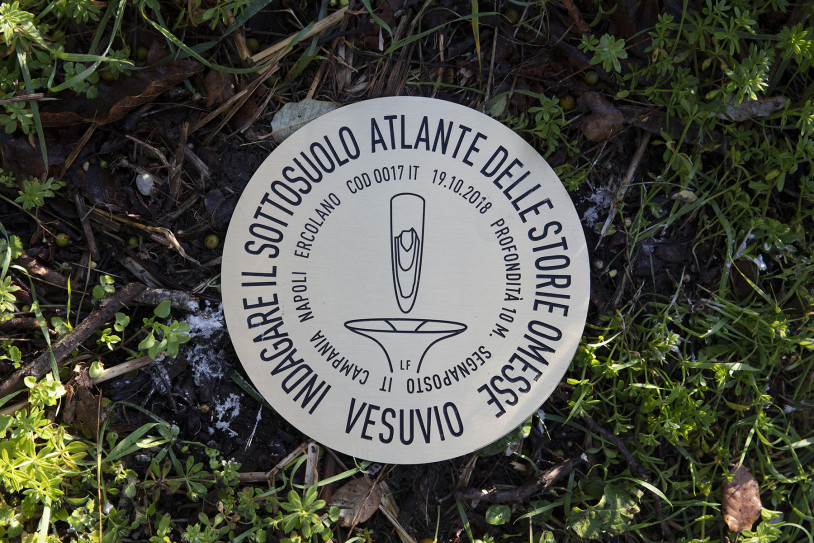
During the Second World War, Vesuvius was targeted in a number of aerial bombardments. The Royal Air Force carried out many raids on the volcano, and its slopes became like a minefield, with large quantities of unexploded ordnance, while the bombs that did go off made it look like the surface of the moon. The Vesuvius Observatory, which was set up in 1841 to study the unpredictable activity of the volcano, was a front-row witness to the effects of the war. The necessary instruments and knowledge were lacking, but they were gradually acquired by studying the behaviour of the volcano, and seismographs – which were initially made almost by hand – became increasingly sensitive, until the world’s first electromagnetic seismograph was installed in 1863. As well as scientific instruments, the Observatory also has a collection of lava medals, which were first made in the nineteenth century, using magma that flowed directly from Vesuvius. The subjects they portray include mythological scenes and portraits of important personalities, ranging from Napoleon to Mussolini. The collection was damaged during the war.
In the Second World War, the Observatory recorded one of the most intense volcanic activities just as Italy entered the conflict, and it was accompanied by rumblings of Vesuvius in June 1940, while bombing raids were repeatedly carried out in the area from 1943. Bomber pilots at the time targeted the cone of Vesuvius. Paradoxically, a similar “experiment” had been attempted in 1922 by the volcanologists of the Observatory, in order to blow up the magma column that was about to emerge. On the evening of 1 November 1944, a very strong wind was lashing at the terrace of the Observatory, making it impossible to the scholars to stay. After a few minutes of the usual whistles and explosions of bombs falling behind the building, an anomalous blast was felt. There are those who say that the cone was damaged, causing the lava to flow, but other scholars believe the hypothesis is not credible because the seismic recordings of the event are missing. Even though the link between the bombing raids and the activity of the volcano has never been proved, the targeting still made an interesting contribution, in scientific rather than military terms: examining the seismographic recordings and comparing the times with those of the most violent explosions, it was possible to calculate the propagation velocity of the relative earthquakes caused, obtaining a sort of deep X-ray of the volcano. The final count was 162 bombs dropped on Vesuvius, and the data obtained led to an initial, well-founded hypothesis concerning the internal and underground conformation of the volcano.

The 0017 core sampling site is in front of the main entrance of the historic Vesuvius Observatory, which was set up in 1841 by Ferdinand II on the slopes of the Somma-Vesuvius volcano system.
The Somma-Vesuvius is a composite polygenic volcano layer that reaches a maximum height of 1,281 m ASL. It is a classic caldera-type volcano, with Monte Somma occupying most of the northern sector. This is the remains of the ancient volcano edifice, with the Gran Cono, inside the old crater, which has grown in successive stages. The two features are separated by the Atrio del Cavallo and the Valle dell’Inferno.
The Somma-Vesuvius area has been active for the past 400,000 years, as indicated by the presence of lava and tuffs interspersed with marine sediments, core-sampled in the south-eastern portion of the volcano at a depth of 1350 m.
The activity of the Somma-Vesuvius is very variable and appears in three main forms: effusive eruptions with the emission of lava flows and, subordinately, flows produced by effusive-explosive activity (lava outflows and ejection of scoria, pumice and ash); explosive eruptions of the sub-Plinian type with distribution of the ejecta (pumice and ash) and pyroclastic flow deposits (e.g. the eruptions of AD 472 and 1631; and, lastly, catastrophic eruptions of the Plinian type with outflows, pyroclastic surges, mudslides and ejecta reaching up to hundreds of kilometres away (e.g. the eruption of AD 79 and the Avellino Pumice eruption). During this third type of eruption, large quantities of ash and lapilli, bombs and scraps of molten lava are violently erupted from the central crater and are accompanied by the ejection of moderately fluid lava flows.
Where the ground is uneven, the pyroclastic flows are channelled into the valleys.The Monte Somma caldera, on the other hand, forms a morphological barrier for the lava flows from the central volcano. There are three main sectors of the volcanic area: the NW-NE sector, which includes the area in question, is mainly affected by primary and secondary pyroclastic flows and by ejecta; the NE-SE sector with pyroclastite ejecta and intercalations of materials from pyroclastic flows; SE-NW sector with lava and pyroclastic flows.
The stratigraphic sequence below the current humus consists of the products of historic Vesuvian eruptions, interlayered by paleosols, which formed during the intervals between the various eruptions.
In particular, generally dark grey pyroclastites were found, together with stretches of black scoria from the eruptions of 1906 and, probably, from those of 1631 and AD 472 (the Pollena eruption).
A further paleosol, at between -2.45 and -2.80 m below ground level, covers the products of the Vesuvian eruption of AD 79 (the so-called Pompeii eruption) consisting of laminated fine and medium-fine ash.
Between -2.80 and -5.40 m are the products of the AD 79 eruption, mainly consisting of laminated ash. From -5.40 to -7.40 m below ground level, the deposit has a massive texture and includes pumice from subcentimetre size to 3 cm and lithic fragments, generally small, attributable to pyroclastic flows with white pumice (on the lower level) and grey pumice. Below this, between -7.74 and -7.70 m below ground level, we find cineritic deposits from the initial phase of the eruption.
The sequence below consists of partly reworked, humified cineritic deposits, probably from the eruptive cycle in the protohistoric age of the so-called AP eruptions.











































